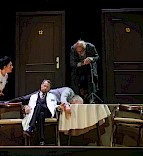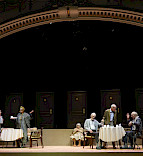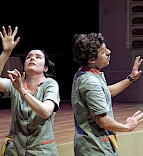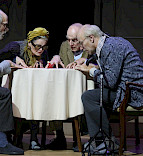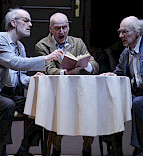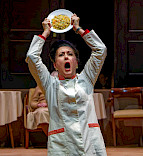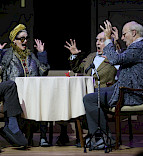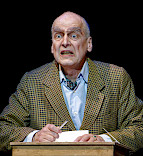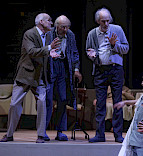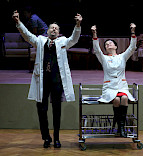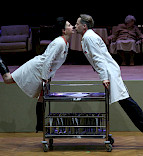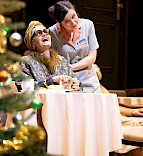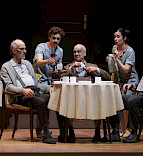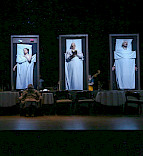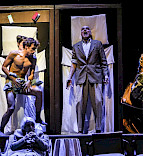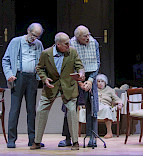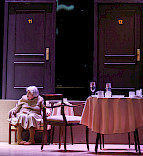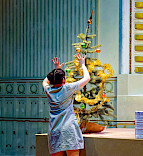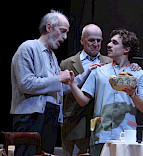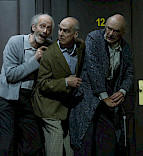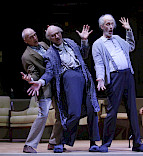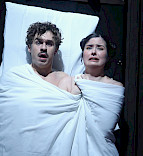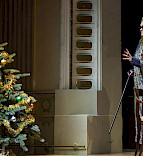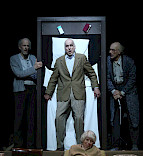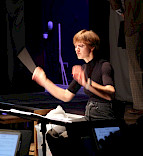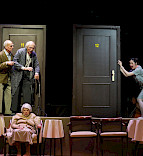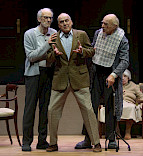Die Musik
Das Libretto der „Abendsonne“ zu vertonen war eine sehr spannende und dankbare Aufgabe, denn diese Textvorlage hat mich ermutigt auch im musikalischen Sinne die Grenzen auszuloten. Schnelle Wechsel zwischen grotesken, absurden Motiven und tragischen, dramatischen Momenten sind für diese Tragikomödie charakteristisch.
In der Musik habe ich zahlreiche Anspielungen und Andeutungen an berühmte Werke der Opernliteratur oder repräsentative Stile der vergangenen Epochen verwendet, um die charakteristischen Momente meiner Oper noch bildhafter zu machen. Mal ist es ein verstecktes Zitat aus „Hänsel und Gretel“ von Humperdinck der eine märchenhafte Illusion verstärken sollte, mal ist es eine wagnerianische Ernsthaftigkeit und Zeitlosigkeit der extrem tiefen Register, mal ein sich nach einer weit zurückliegenden Jugend sehnender Tango. Alle diese Einblicke in die Musikgeschichte, dieses immer wieder Zurückgehen auf der Zeitachse, knüpft an das Hauptthema der Oper an – an das Alter, und an den Versuch das kompromisslose, unaufhaltsame Fortschreiten der Zeit zu akzeptieren. Auch im musikalischen Sinne prallen in dieser Komposition zwei Welten aufeinander – die realistische, kompromisslose und die irrationale.
Jedes Mal, wenn es zu einem Versuch kommt, den Kontakt mit den Geistern aus dem Jenseits herzustellen, versetzt uns die Musik in eine Illusion einer sich immer beschleunigenden, besessenen Rotation, die uns aus unserem Leben „auf die andere Seite“ ziehen möchte.
Die Gewissheit, dass jeder von uns immer älter wird und somit auch seinem Ende näher kommt, trägt immer die zwei Merkmale einer Tragikomödie in sich – einerseits ist es die Angst vor dem Sterben, ein Drama, wenn man sich dem Schicksal entgegenstellen will, andererseits ein gewisser gelassener humoristischer Zugang, der uns erlaubt, das Gesetz der Natur zu akzeptieren.
******************************************************************************************S
Setting the libretto of ‘Abendsonne’ to music was a very exciting and rewarding task, as this text encouraged me to push the boundaries musically as well. Rapid changes between grotesque, absurd motifs and tragic, dramatic moments are characteristic of this tragicomedy.
In the music, I have used numerous allusions and allusions to famous works of opera literature or representative styles of past eras to make the characteristic moments of my opera even more vivid. Sometimes it is a hidden quotation from Humperdinck's ‘Hansel and Gretel’ intended to reinforce a fairytale illusion, sometimes it is a Wagnerian seriousness and timelessness of the extremely low registers, sometimes a tango longing for a distant youth. All these glimpses into musical history, this constant going back in time, are linked to the main theme of the opera - age and the attempt to accept the uncompromising, unstoppable progression of time. In a musical sense, too, two worlds collide in this composition - the realistic, uncompromising and the irrational.
Every time there is an attempt to make contact with the spirits from the afterlife, the music transports us into an illusion of an ever-accelerating, obsessive rotation that wants to pull us out of our lives ‘to the other side’.
The certainty that each of us is getting older and thus closer to our end always carries the two characteristics of a tragicomedy - on the one hand it is the fear of dying, a drama when one wants to confront fate, and on the other hand a certain serene humour that allows us to accept the law of nature.

